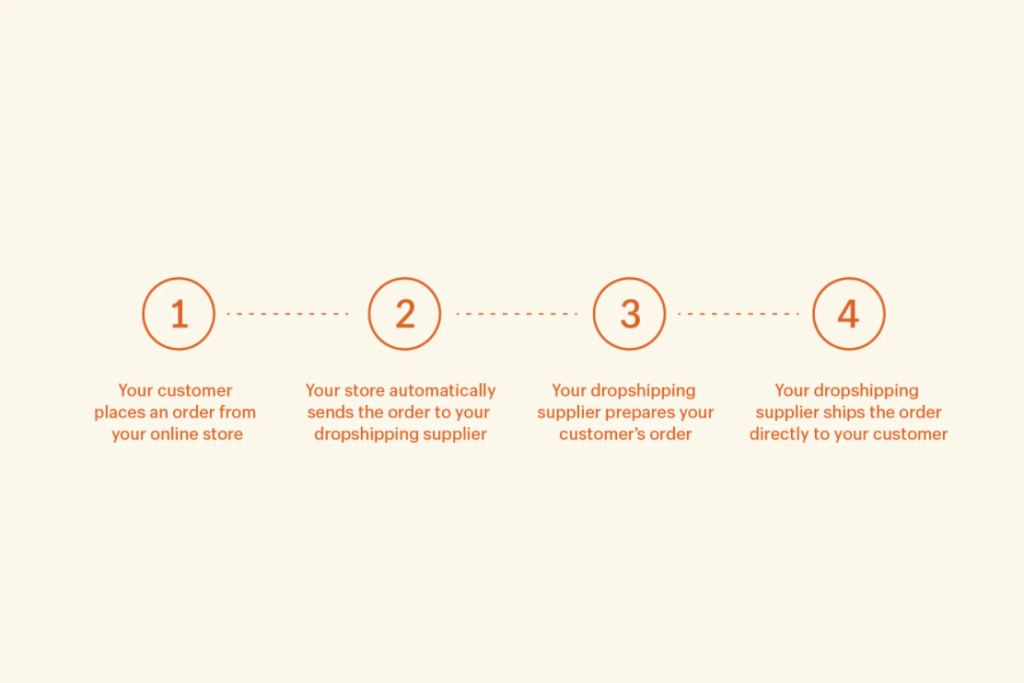
Dropshipping is an order fulfillment method where a business doesn’t keep the products it sells in stock. Instead, the seller purchases inventory as needed from a third party—usually a wholesaler or manufacturer—to fulfill orders.
The biggest difference between drop shipping and the standard retail model is that the selling merchant doesn’t stock or own inventory—they act as the middleman.
A drop shipper is a person or business that uses the dropshipping model of buying inventory and fulfillment logistics from a third party, instead of warehousing and shipping the products themselves.
Because dropshipping relies on a third-party supplier to handle inventory warehousing and order fulfillment, a drop shipping operation may be managed by dozens of employees or a single business owner.
The dropshipping process is essentially a relationship between a customer-facing store and a supplier.
There are two common approaches to adopting a dropshipping business model. The first is to seek out one or more wholesale suppliers located in North America (or anywhere else in the world) on your own using a supplier database. Examples of popular online supplier databases include AliExpress, SaleHoo, and Worldwide Brands.
If you’re not interested in finding suppliers for all of the products you plan to sell, you can use an app that connects you and your store to thousands of suppliers. For this, we recommend DSers, a Shopify app that helps independent business owners find products to sell.
With DSers, you can browse AliExpress and import the products that pique your interest directly to DSers—which is connected to your Shopify store—with the click of a button. Once a customer buys a product, you’ll be able to fulfill their order in the DSers app.
Fortunately, DSers automates most of the dropshipping process. As the store owner, all you have to do is check that the details are correct and click the order button. The product is then shipped directly from the AliExpress supplier to the customer—wherever in the world they may be.

Dropshipping is often seen as a no-hassle, get-rich-quick scheme. But it’s not. Just like any other ecommerce website, it takes dedication to get your startup running and successful. Done well, dropshipping companies can become reliable and convenient partners to growing ecommerce businesses to expedite order and fulfillment processing.
Here are a few other reasons why dropshipping is such a popular ecommerce business model for both large and small businesses.
Probably the biggest advantage to dropshipping is that it’s possible to launch an ecommerce store without having to invest thousands of dollars in inventory. Traditionally, a brick-and-mortar or ecommerce retailer has to tie up huge amounts of capital purchasing inventory.
With the dropshipping model, you don’t have to purchase a product unless you’ve already made the sale and have been paid by the customer. Without significant upfront inventory investments, it’s possible to start dropshipping and become successful with very little money.
Additionally, because you’re not committed to selling through any inventory purchased upfront, like in other business models, there’s less risk involved in starting a dropshipping store.
Running an ecommerce business is much easier when you don’t have to deal with physical products. With dropshipping, you don’t have to worry about:
Because you don’t have to deal with purchasing inventory or managing fulfillment centers, your overhead expenses are quite low. In fact, many successful dropshipping stores are run as home-based businesses, requiring little more than a laptop and a few recurring expenses to operate.
As you grow, these costs will likely increase, but will still be low compared to those of traditional brick-and-mortar businesses.
With dropshipping, a successful business can be run from just about anywhere with an internet connection. As long as you can communicate with suppliers and provide timely service and support that meets customer expectations, you can run and manage your business.
Since you don’t have to pre-purchase the items you sell, you can offer an array of trending products to your potential customers. Plus, you can rotate or change your dropshipping products list without having to worry about unsold inventory. If suppliers stock an item, you can list it for sale on your online store at no additional cost.
Dropshipping is a useful fulfillment model for both launching a new store and for business owners looking to test the appetite customers have for additional product categories, e.g., accessories or wholly new product lines. The main benefit of dropshipping is, again, the ability to list and potentially sell products before committing to buying a large amount of inventory.
With a traditional retail business, if you receive three times the number of orders, you’ll usually need to do three times as much work. By leveraging dropshipping suppliers, most of the work to process additional orders will be done by the suppliers, allowing you to expand with fewer growing pains and less incremental work.
Sales growth will always bring additional work—especially related to customer support—but businesses that utilize dropshipping scale particularly well relative to traditional ecommerce businesses.